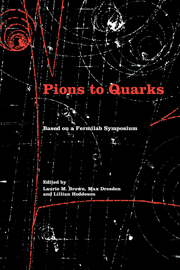Book contents
- Frontmatter
- Contents
- List of contributors
- Foreword by Leon M. Lederman
- Editors' acknowledgments
- Photographs of the symposium
- List of abbreviations
- List of notation
- I Introduction
- II Particle discoveries in cosmic rays
- III High-energy nuclear physics
- IV The new laboratory
- V The strange particles
- 19 The hydrogen bubble chamber and the strange resonances
- 20 A particular view of particle physics in the fifties
- 21 Strange particles
- 22 Strange particles: production by Cosmotron beams as observed in diffusion cloud chambers
- 23 From the 1940s into the 1950s
- VI Weak interactions
- VII Weak interactions and parity nonconservation
- VIII The particle physics community
- IX Theories of hadrons
- X Personal overviews
- Name index
- Subject index
23 - From the 1940s into the 1950s
Published online by Cambridge University Press: 07 May 2010
- Frontmatter
- Contents
- List of contributors
- Foreword by Leon M. Lederman
- Editors' acknowledgments
- Photographs of the symposium
- List of abbreviations
- List of notation
- I Introduction
- II Particle discoveries in cosmic rays
- III High-energy nuclear physics
- IV The new laboratory
- V The strange particles
- 19 The hydrogen bubble chamber and the strange resonances
- 20 A particular view of particle physics in the fifties
- 21 Strange particles
- 22 Strange particles: production by Cosmotron beams as observed in diffusion cloud chambers
- 23 From the 1940s into the 1950s
- VI Weak interactions
- VII Weak interactions and parity nonconservation
- VIII The particle physics community
- IX Theories of hadrons
- X Personal overviews
- Name index
- Subject index
Summary
This brief memoir deals with some subjects I was involved with or that otherwise came to my notice during the period from July 1946 through June 1953. A memoir, according to the Oxford English Dictionary, is a record of events “not purporting to be a complete history, but treating of such matters as come within the personal knowledge of the writer, or are obtained from certain particular sources of information.” During the last few years I have had occasion to consult numerous memoirs, some old, some recent, because I have been writing a book on the history of particles and fields. I was not surprised to find that I did not always agree with what those memoirs said (as, for example, in regard to the genesis of the neutral-K particle mixing idea). Nor did they always agree with each other. Such variants can be revealing, and sometimes even interesting, but should, of course, always take second place compared with the published scientific record.
Now to July 1946. That was the time of the first international post–World War II physics conference, held at the Cavendish Laboratory. I was coauthor of two papers presented there. The first, written with Lamek Hulthen, dealt with calculations of n–p scattering up to 25 MeV. In this work, noninteger orbital angular momentum played the role of a variational parameter. This paper is of some interest because it was stimulated by nucleon–nucleon scattering experiments at the highest energy then reached. In September 1945, Rubby Sherr had scattered 25-MeV neutrons, produced at the Harvard cyclotron, off protons.
- Type
- Chapter
- Information
- Pions to QuarksParticle Physics in the 1950s, pp. 348 - 356Publisher: Cambridge University PressPrint publication year: 1989
- 1
- Cited by



